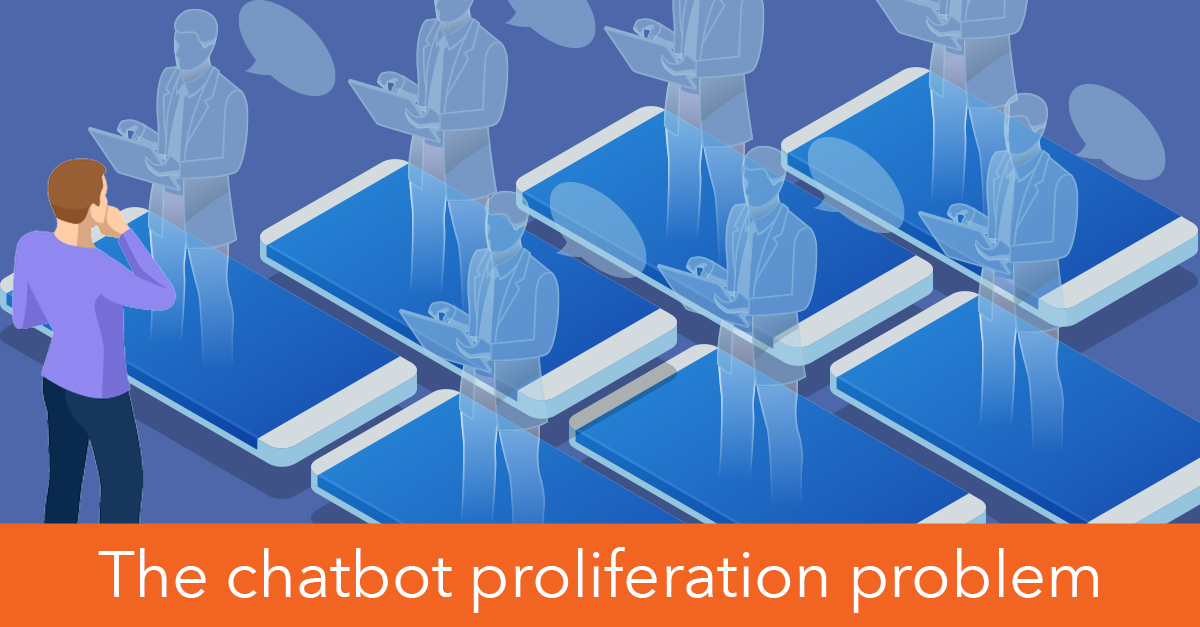The Chatbot Proliferation Problem: Avoiding Fragmentation

Chatbots or digital assistants will soon be embedded into all online services that are used by our students, teachers and support teams.
What does this mean for schools, colleges and universities?
Will they welcome the influx of bots on their campuses or would they prefer to utilise the services of a single general purpose digital assistant on their campuses?
Students and teachers in a typical campus utilise numerous online services.
This means that end users could be presented with multiple chatbots or digital assistants; especially if these services are managed by different vendors.
If this is the case, a student’s interaction with an individual chatbot could be limited to the online service that they are currently engaged with.
In the worse case scenario, a student will have to open the institution’s learning management system to converse with the LMS chatbot about forthcoming assignments or tutorial topics; and the student will have to engage with the library chatbot or digital assistant to renew book loans.
This invariably leads to a fragmented chatbot service. The same holds true for all the services that teachers and support teams use.

What options do institutions face?
- In the first instance, the campus could have a single chatbot or digital assistant. In this instance, the chatbot is connected to all key datasets across the campus, including knowledge domains beyond the campus. The institution has complete control of the end user experience and is able to offer a contextualised service to individuals who use the service. The service that is provided to the end user is frictionless.
- Secondly, the campus could have a primary chatbot that students and staff engage with. It hands over tasks to service specific chatbots and returns an answer to the student or staff member via the primary chatbot. This solution assumes interoperability between vendor chatbot services.
- Thirdly, the campus could decide to utilise multiple chatbots or digital assistants which are service or knowledge domain specific. This solution is easier to roll out across the campus but the service offers a fractured experience to the end user.
In an ideal setting students, teachers and support teams will converse with a single digital assistant. The service will be connected to all key datasets at the institution; enabling a wide range of questions to be answered and it will support individuals to carry out numerous tasks and activities.
A student could ask the chatbot about a forthcoming assignment deadline date, she could then use the service to send a message to her tutor and then close the session by renewing her library books.
Students and staff will also be able to access the same quality of service on their smartphones and smart speakers. This is the strategy that Bolton College has adopted for its chatbot service.
Agents
As well as a proliferation of chatbots or digital assistants there will also be a growth in agents that shape the day-to-day behaviour of the campus chatbot.
An agent, at a simple level, will observe what the student or teacher has asked of the chatbot and offer additional information or services that supports the enquiry. For example, a student may enquire about a forthcoming assignment deadline date; and the chatbot will present the date and time to the student.
Having observed the question, the agent which is tasked with raising average assignment grades will also present information, advice and guidance through the chatbot to the student about the grade that is required to either maintain or increase his grade average.
These agents prompt, guide, direct and support each student through their studies. They never sleep, they are always available to support students, they constantly monitor student progress, they learn from their mistakes, they constantly improve and they behave cooperatively with their fellow agents.
For example, a library agent could enable the digital assistant to suggest a reading list to a student who has just asked for details about a forthcoming assignment or an agent may help the digital assistant to nudge a teacher to flag a student who is performing below par with their studies.
The use of agents means that campus chatbots or digital assistants will be able to provide timely information, advice and guidance to all students, teachers and support teams.
Summary
If schools, colleges and universities want to improve the quality of services that they offer to their students the adoption of campus chatbots or digital assistants will be widespread; especially when chatbots enable institutions to deliver one-to-one support at scale and at all hours of the day.
Vendors who offer learning management systems or information systems to the education sector will invariably embed chatbots into their platforms. The rise of these services will need to be carefully managed; otherwise the students and staff on the campus will end up receiving a rather fractured and confused service. My personal preference is for a single general purpose digital assistant for the campus.

There are many other reasons why I advocate the use of a single chatbot or digital assistant for students, teachers and support teams. These are best described in the following thought experiment.
Imagine a new student called Yasmin who arrives on the campus at the start of a new academic year. She is informed by her tutor that the college has a digital assistant called Ada which can be accessed on the web, smartphones, smart speakers and smart watches.
She learns that Ada is there to support her with every interaction on the campus which includes messaging teachers, engaging with online tutorials, submitting coursework, booking appointments with staff and so on and so forth.
The digital assistant is aware of Yasmin’s entry qualifications and it is aware that she is hoping to progress onto university at the end of her two year course. Ada will offer information, advice and guidance to Yasmin as she makes progress with her studies.
This may include providing feedback on coursework, suggesting suitable reading lists and learning resources to Yasmin, advising about the target grades for forthcoming assignments and offering dates and times for suitable events around the campus to support her university application.
Ada has access to all key datasets at the college, including anonymised historical student records. These datasets inform and improve the machine learning models that govern Ada’s interactions with students. Overtime, Ada becomes more proficient at supporting students with their studies.
Thomas started work as a new teacher on the same day as Yasmin. Thomas is also introduced to the college’s digital assistant. He learns that Ada has set the teaching timetable for his first term at the college.
He also learns that Ada supports his course team to manage student progress during the course of their studies. Ada marks the diagnostic test that Thomas’ students undertake at the start of their studies at the college; and uses this information to design an individual and personalised learning pathway for all his students.
Thomas and his course team hold weekly meetings and he is surprised to learn that they talk to Ada during these meetings. Thomas asks Ada about the diagnostic test results for the course. Ada presents the data on a screen for the course team to view.
They ask Ada about the students who scored low on the test. She tells the course team that all these students have learning support needs and some of these students had no entry qualifications for maths.
As Thomas and his colleagues continue to converse with Ada, they become informed about how best to support each student on their course. Ada tells Thomas and the course team that follow up support sessions have already been arranged for the students who scored low on the diagnostic test.
In fact she completed that task within a second of recording the mark for each student. Thomas discovers that being a teacher at this college is going to be quite different from his last place of work.
The technology that underpins the behaviour of the digital assistant is already in place. It just needs to be combined and used in a manner which is new to the education sector.
Aftab Hussain, Strategic ILT Lead, Bolton College












Responses